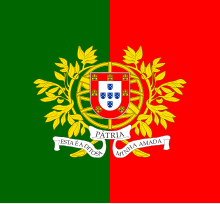Portuguese Armed Forces
|
|||

|
|||
| guide | |||
|---|---|---|---|
| Commander in Chief : | President of Portugal | ||
| Defense Minister: | José Azeredo Lopes | ||
| Military strength | |||
| Active soldiers: | 30,000 (2019) | ||
| Conscription: | suspended (2003) | ||
| Eligibility for military service: | 18th year of life | ||
| household | |||
| Military budget: | 2.928 billion euros (2019) | ||
| Share of gross domestic product : | 1.41% (2019) | ||
| history | |||
The Portuguese Armed Forces ( Portuguese : Forças Armadas Portuguesas ) are subordinate to the Ministry of Defense of the Republic of Portugal and consist of the armed forces:
- Portuguese Army Exército Português
- Portuguese Navy Marinha Portuguesa
- Portuguese Air Force Força Aérea Portuguesa
- Republican National Guard Guarda Nacional Republicana
The president , who is directly elected every five years in a general election, is the commander in chief of the armed forces.
The general conscription that prevailed until 2003 is suspended. The period of service was:
- 4–8 months of land forces
- 4–12 months naval or air force
history
As the leading colonial power, Portugal had had a relatively strong army for the size of the country since the Middle Ages, but above all a very strong navy. The general weakness of the country, economic problems (national bankruptcy in 1891) and increasing republican uprisings led to the proclamation of the republic in 1910. In March 1916, the country joined the First World War on the side of the Entente . Portugal mobilized an expeditionary force of up to 100,000 soldiers, of which about 7,000 were killed by the end of the war. During World War II , the country was neutral, although Japan occupied Macau and Portuguese Timor (see Battle of Timor ). Portugal has been a member of NATO since 1949 . From 1960 the colonial war began , which was waged with great severity, especially in Africa ( Angola , Mozambique , Guinea-Bissau ), but not from Portugal despite the deployment of up to 150,000 colonial troops, settler militias, local auxiliary soldiers and South African or South Rhodesian mercenaries could be won. With the Carnation Revolution in 1974, a bloodless military coup ended the decades-long dictatorship of the Estado Novo . After democratic elections in 1975, the military slowly withdrew from politics. Portugal now has a small but relatively modern navy.
During the Second Gulf War , Portugal was a member of the US- led coalition against Iraq. From 1999 the Portuguese armed forces were involved in the International Armed Forces East Timor (INTERFET) and International Stabilization Force (ISF) in East Timor , and since 2001 also in the International Security Assistance Force (ISAF) in Afghanistan .
Crew numbers and equipment


Team numbers
- Army: approx.17,800
- Navy: approximately 8,600
- Air Force: approx. 6,600
Source:
equipment
- army
- 224 main battle tanks (37 Leopard 2 A6 (NL)
- 101 M60
- 86 M48A5 )
- Air force:
- Fighter aircraft ( Lockheed Martin F-16 Fighting Falcon )
- Maritime patrol aircraft ( Lockheed P-3 Orion , CASA C-295 )
- Transport aircraft (including Lockheed Martin C-130 Hercules )
- Helicopter ( AgustaWestland AW101 Merlin , Aérospatiale SA-319 Alouette III )
- Training planes and helicopters
- marine
- 1 submarine NRP Barracuda ( Albacora class )
- 2 submarines of the type 209PN , NRP Tridente and NRP Arpão
- 5 frigates (3 Vasco da Gama class, one MEKO design, 2 Bartolomeu Dias class )
- 30 patrol boats
See also
Individual evidence
- ↑ a b c "Defense Expenditure of NATO Countries (2012-2019)", Press Release Communique PR / CP (2019) 069, NATO Public Diplomacy Division, June 29, 2019 (PDF, 128kB)
- ↑ International Institute for Strategic Studies: The Military Balance (2002)
- ^ Organização - As Forças Armadas . In: emgfa.pt . Estado-Maior-General das Forças Armadas. Retrieved January 20, 2017.
